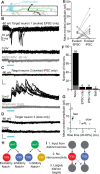Clonally related, Notch-differentiated spinal neurons integrate into distinct circuits
- PMID: 36580075
- PMCID: PMC9799969
- DOI: 10.7554/eLife.83680
Clonally related, Notch-differentiated spinal neurons integrate into distinct circuits
Abstract
Shared lineage has diverse effects on patterns of neuronal connectivity. In mammalian cortex, excitatory sister neurons assemble into shared microcircuits. In Drosophila, in contrast, sister neurons with different levels of Notch expression (NotchON/NotchOFF) develop distinct identities and diverge into separate circuits. Notch-differentiated sister neurons have been observed in vertebrate spinal cord and cerebellum, but whether they integrate into shared or distinct circuits remains unknown. Here, we evaluate how sister V2a (NotchOFF)/V2b (NotchON) neurons in the zebrafish integrate into spinal circuits. Using an in vivo labeling approach, we identified pairs of sister V2a/b neurons born from individual Vsx1+ progenitors and observed that they have somata in close proximity to each other and similar axonal trajectories. However, paired whole-cell electrophysiology and optogenetics revealed that sister V2a/b neurons receive input from distinct presynaptic sources, do not communicate with each other, and connect to largely distinct targets. These results resemble the divergent connectivity in Drosophila and represent the first evidence of Notch-differentiated circuit integration in a vertebrate system.
Keywords: Notch; clonal relationships; development; motor circuit; motor neurons; motor systems; neuroscience; notch signaling; sister neurons; spinal cord; v2a neuron; v2b neuron.
Plain language summary
The brain is populated by neurons which are generated during embryonic development from cells called progenitors. Neurons that come from the same progenitor cell are considered to be ‘sisters’. In certain brain regions of mice, sister neurons are often wired into shared networks, meaning they are more likely to receive input from the same neurons and connect with each other than non-sister cells. In contrast, in invertebrate animals, like the fruit fly, sister neurons often have different identities and are less likely to connect with each other. This may be because sister neurons in fruit flies often have varied levels of a protein called Notch, which plays an important role in establishing the identity of cells. Vertebrate and invertebrate animals are different in many respects, and it remained unclear whether Notch levels dictate which sister neurons connect together in vertebrates as they do in fruit flies. To investigate, Bello-Rojas and Bagnall studied two neurons in the spinal cord of zebrafish embryos which come from the same type of progenitor cell: the V2a neuron which has low levels of Notch, and the V2b neuron which has high levels of Notch. Fish, like humans, are vertebrates; however, their embryos are mostly transparent, making it easier to track how their neurons make connections during development using a microscope. This enabled Bello-Rojas and Bagnall to monitor whether V2a and V2b sister neurons joined the same network, like in other vertebrates, or different networks, akin to sister neurons in fruit flies which also have differing levels of Notch. Bello-Rojas and Bagnall found that sister V2a and V2b neurons stayed close to one another and seemed to connect through similar paths. However, closer investigation revealed that the sister neurons did not receive input from the same source. They also did not connect to each other or the same output neuron, suggesting that V2a and V2b sister neurons are part of different networks. This is the first time Notch levels have been shown to regulate which network a neuron will join in a vertebrate species. Since the V2a and V2b neurons are involved in controlling body movement, future work should determine whether adding progenitor cells that produce these neurons into the spinal cord could help the neuron network recover after injury or disease.
© 2022, Bello-Rojas and Bagnall.
Conflict of interest statement
SB, MB No competing interests declared
Figures







References
Publication types
MeSH terms
Associated data
Grants and funding
LinkOut - more resources
Full Text Sources
Other Literature Sources
Molecular Biology Databases
Research Materials
Miscellaneous

